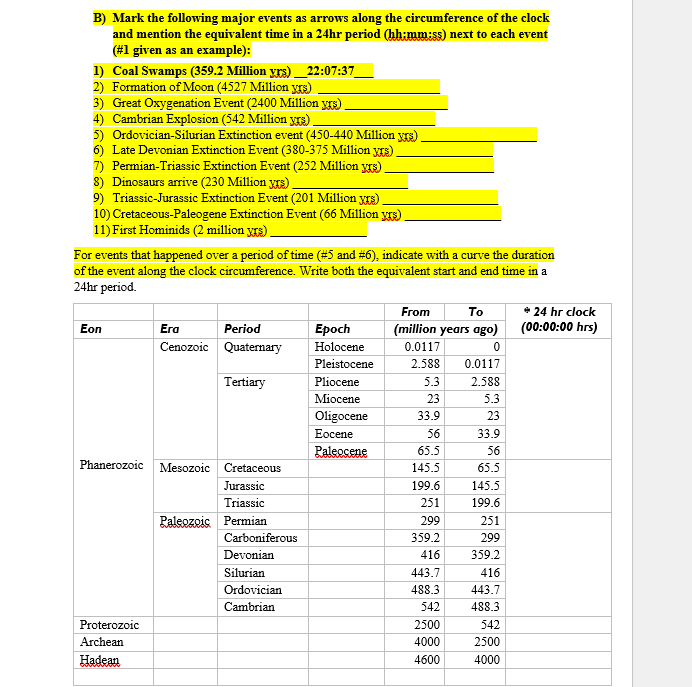we will be compressing the age of the Earth to one day to get an idea about the relative duration of each period in Earth’s history and when major events took place. Age of the Earth: 4.6 Billion years Fit the Eons (Hadean, Archean, Proterozoic, Phanerozoic) and Eras of the Phanerozoic (Paleozoic, Mesozoic and Cenozoic) into the 24hr clock. Assume: 00:00:00 to be Earth’s “birthday” and 24:00:00 to be today. Use colored pencils to color in different time periods in the clock and label everything clearly. Show all the necessary calculations in the blank page of this handout. Fill the column indicating the equivalent time (00:00:00 hrs) in a 24 hr time period.
we will be compressing the age of the Earth to one day to get an idea about the relative duration of each period in Earth’s history and when major events took place. Age of the Earth: 4.6 Billion years Fit the Eons (Hadean, Archean, Proterozoic, Phanerozoic) and Eras of the Phanerozoic (Paleozoic, Mesozoic and Cenozoic) into the 24hr clock. Assume: 00:00:00 to be Earth’s “birthday” and 24:00:00 to be today. Use colored pencils to color in different time periods in the clock and label everything clearly. Show all the necessary calculations in the blank page of this handout. Fill the column indicating the equivalent time (00:00:00 hrs) in a 24 hr time period.
Applications and Investigations in Earth Science (9th Edition)
9th Edition
ISBN:9780134746241
Author:Edward J. Tarbuck, Frederick K. Lutgens, Dennis G. Tasa
Publisher:Edward J. Tarbuck, Frederick K. Lutgens, Dennis G. Tasa
Chapter1: The Study Of Minerals
Section: Chapter Questions
Problem 1LR
Related questions
Question
we will be compressing the age of the Earth to one day to get an idea about the relative duration of each period in Earth’s history and when major events took place.
Age of the Earth: 4.6 Billion years
- Fit the Eons (Hadean, Archean, Proterozoic, Phanerozoic) and Eras of the Phanerozoic (Paleozoic, Mesozoic and Cenozoic) into the 24hr clock. Assume: 00:00:00 to be Earth’s “birthday” and 24:00:00 to be today. Use colored pencils to color in different time periods in the clock and label everything clearly. Show all the necessary calculations in the blank page of this handout. Fill the column indicating the equivalent time (00:00:00 hrs) in a 24 hr time period.

Transcribed Image Text:B) Mark the following major events as arrows along the circumference of the clock
and mention the equivalent time in a 24hr period (hb:mm:ss) next to each event
(#1 given as an example):
1) Coal Swamps (359.2 Million yrs) _22:07:37_
2) Formation of Moon (4527 Million yrs)
3) Great Oxygenation Event (2400 Million wys)
4) Cambrian Explosion (542 Million yE)
5) Ordovician-Silurian Extinction event (450-440 Million yrs)
6) Late Devonian Extinction Event (380-375 Million yrs)
7) Permian-Triassic Extinction Event (252 Million yrs)
8) Dinosaurs arrive (230 Million yrs)
9) Triassic-Jurassic Extinction Event (201 Million yrs)
10) Cretaceous-Paleogene Extinction Event (66 Million yrs)
11) First Hominids (2 million s).
For events that happened over a period of time (#5 and #6), indicate with a curve the duration
of the event along the clock circumference. Write both the equivalent start and end time in a
24hr period.
* 24 hr clock
(00:00:00 hrs)
From
To
Eon
Era
Period
Ероch
(million years ago)
Cenozoic Quaternary
Holocene
0.0117
Pleistocene
2.588
0.0117
Tertiary
Pliocene
5.3
2.588
Miocene
23
5.3
Oligocene
33.9
23
Eоcene
56
33.9
Raleccene
65.5
56
Phanerozoic
Mesozoic Cretaceous
145.5
65.5
Jurassic
199.6
145.5
Triassic
251
199.6
Paleozois Permian
299
251
Carboniferous
359.2
299
Devonian
416
359.2
Silurian
443.7
416
Ordovician
488.3
443.7
Cambrian
542
488.3
Proterozoic
2500
542
Archean
4000
2500
Hadean
4600
4000
Expert Solution
This question has been solved!
Explore an expertly crafted, step-by-step solution for a thorough understanding of key concepts.
Step by step
Solved in 4 steps

Recommended textbooks for you

Applications and Investigations in Earth Science …
Earth Science
ISBN:
9780134746241
Author:
Edward J. Tarbuck, Frederick K. Lutgens, Dennis G. Tasa
Publisher:
PEARSON

Exercises for Weather & Climate (9th Edition)
Earth Science
ISBN:
9780134041360
Author:
Greg Carbone
Publisher:
PEARSON

Environmental Science
Earth Science
ISBN:
9781260153125
Author:
William P Cunningham Prof., Mary Ann Cunningham Professor
Publisher:
McGraw-Hill Education

Applications and Investigations in Earth Science …
Earth Science
ISBN:
9780134746241
Author:
Edward J. Tarbuck, Frederick K. Lutgens, Dennis G. Tasa
Publisher:
PEARSON

Exercises for Weather & Climate (9th Edition)
Earth Science
ISBN:
9780134041360
Author:
Greg Carbone
Publisher:
PEARSON

Environmental Science
Earth Science
ISBN:
9781260153125
Author:
William P Cunningham Prof., Mary Ann Cunningham Professor
Publisher:
McGraw-Hill Education

Earth Science (15th Edition)
Earth Science
ISBN:
9780134543536
Author:
Edward J. Tarbuck, Frederick K. Lutgens, Dennis G. Tasa
Publisher:
PEARSON

Environmental Science (MindTap Course List)
Earth Science
ISBN:
9781337569613
Author:
G. Tyler Miller, Scott Spoolman
Publisher:
Cengage Learning

Physical Geology
Earth Science
ISBN:
9781259916823
Author:
Plummer, Charles C., CARLSON, Diane H., Hammersley, Lisa
Publisher:
Mcgraw-hill Education,